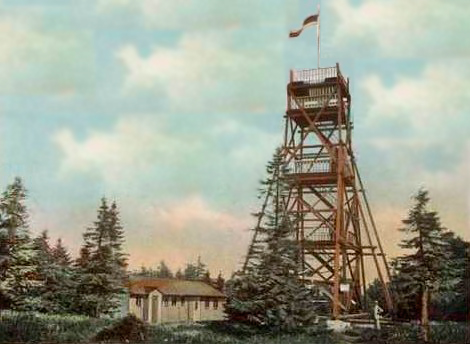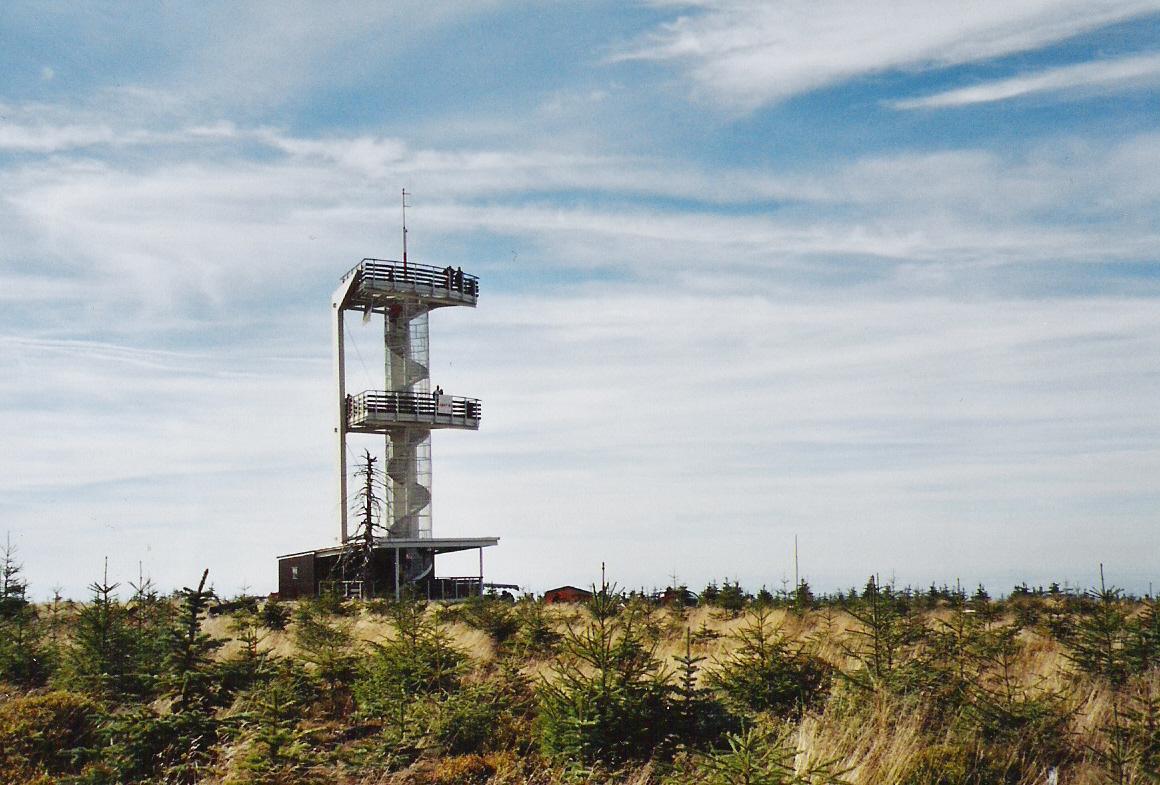Smrk (Jizera) on:
[Wikipedia]
[Google]
[Amazon]
Smrk (; ) is the highest mountain in the

 The "Tabulový kámen" (''Tafelstein'') stone monument on the northern slope marks the site, which since the Middle Ages formed the historic
The "Tabulový kámen" (''Tafelstein'') stone monument on the northern slope marks the site, which since the Middle Ages formed the historic
Czech
Czech may refer to:
* Anything from or related to the Czech Republic, a country in Europe
** Czech language
** Czechs, the people of the area
** Czech culture
** Czech cuisine
* One of three mythical brothers, Lech, Czech, and Rus
*Czech (surnam ...
part of the Jizera Mountains. Rising , it is sometimes known as "The King of the Jizera Mountains".
Geography
The top of the mountain lies in the municipal territory of Lázně Libverda in theLiberec Region
Liberec Region () is an administrative unit (Czech language, Czech: ''kraj'') of the Czech Republic, located in the northernmost part of its historical region of Bohemia. It is named after its capital Liberec. The region shares international bor ...
of northern Bohemia
Bohemia ( ; ; ) is the westernmost and largest historical region of the Czech Republic. In a narrow, geographic sense, it roughly encompasses the territories of present-day Czechia that fall within the Elbe River's drainage basin, but historic ...
. On the eastern rim of the plateau is the boundary with Poland
Poland, officially the Republic of Poland, is a country in Central Europe. It extends from the Baltic Sea in the north to the Sudetes and Carpathian Mountains in the south, bordered by Lithuania and Russia to the northeast, Belarus and Ukrai ...
; the Polish summit west of Świeradów-Zdrój reaches a height of .
The summit offers a panoramic view to the prominent Sněžka
Sněžka () or Śnieżka (, ) is a mountain on the border between the Czech Republic and Poland, the most prominent point of the Silesian Ridge in the Giant Mountains. At , its summit is the highest point in the Czech Republic, in the Lower Siles ...
peak of the Giant Mountains
The Giant Mountains, Krkonoše, or Karkonosze (Czech: , , ), are a mountain range located in the north of the Czech Republic and the south-west of Poland, part of the Sudetes mountain system (part of the Bohemian Massif). The Czech–Polish bor ...
in the east, as well as to the Lusatian Highlands beyond the German border in the west up to the cooling towers of Boxberg Power Station.
History

 The "Tabulový kámen" (''Tafelstein'') stone monument on the northern slope marks the site, which since the Middle Ages formed the historic
The "Tabulový kámen" (''Tafelstein'') stone monument on the northern slope marks the site, which since the Middle Ages formed the historic tripoint
A triple border, tripoint, trijunction, triple point, or tri-border area is a geography, geographical point at which the boundaries of three countries or Administrative division, subnational entities meet. There are 175 international tripoints ...
between
* the Upper Lusatia
Upper Lusatia (, ; , ; ; or ''Milsko''; ) is a historical region in Germany and Poland. Along with Lower Lusatia to the north, it makes up the region of Lusatia, named after the Polabian Slavs, Slavic ''Lusici'' tribe. Both parts of Lusatia a ...
n lordship of ''Meffersdorf'' (Polish: Unięcice, in present-day Pobiedna)
* the Lower Silesian duchy of Jawor
Jawor () is a town in south-western Poland with 22,890 inhabitants (2019). It is situated in the Lower Silesian Voivodeship. It is the seat of Jawor County, and lies approximately west of the regional capital Wrocław.
One of the oldest towns ...
, where the lands around Szklarska Poręba (''Schreiberhau'') were held by the House of Schaffgotsch, and
* the Bohemia
Bohemia ( ; ; ) is the westernmost and largest historical region of the Czech Republic. In a narrow, geographic sense, it roughly encompasses the territories of present-day Czechia that fall within the Elbe River's drainage basin, but historic ...
n territory around Frýdlant (''Friedland'').
The mountain got its name from a once mighty spruce
A spruce is a tree of the genus ''Picea'' ( ), a genus of about 40 species of coniferous evergreen trees in the family Pinaceae, found in the northern temperate and boreal ecosystem, boreal (taiga) regions of the Northern hemisphere. ''Picea'' ...
(, German: ''Fichte'') tree near the border, where the Imperial generalissimo Albrecht von Wallenstein
Albrecht Wenzel Eusebius von Wallenstein, Duke of Friedland (; 24 September 1583 – 25 February 1634), also von Waldstein (), was a Bohemian military leader and statesman who fought on the Catholic side during the Thirty Years' War (1618–16 ...
, after his elevation to a Duke of Friedland, nailed his coat of arms
A coat of arms is a heraldry, heraldic communication design, visual design on an escutcheon (heraldry), escutcheon (i.e., shield), surcoat, or tabard (the last two being outer garments), originating in Europe. The coat of arms on an escutcheon f ...
in 1628. The tree was uprooted, in 1790, by a storm.
Bohemia, Silesia and Lusatia had all been Lands of the Bohemian Crown
The Lands of the Bohemian Crown were the states in Central Europe during the Middle Ages, medieval and early modern periods with feudalism, feudal obligations to the List of Bohemian monarchs, Bohemian kings. The crown lands primarily consisted o ...
since the 14th century, and part of the Austrian Habsburg monarchy
The Habsburg monarchy, also known as Habsburg Empire, or Habsburg Realm (), was the collection of empires, kingdoms, duchies, counties and other polities (composite monarchy) that were ruled by the House of Habsburg. From the 18th century it is ...
from 1526. After Upper Lusatia passed to the Electorate of Saxony
The Electorate of Saxony, also known as Electoral Saxony ( or ), was a territory of the Holy Roman Empire from 1356 to 1806 initially centred on Wittenberg that came to include areas around the cities of Dresden, Leipzig and Chemnitz. It was a ...
during the Thirty Years' War
The Thirty Years' War, fought primarily in Central Europe between 1618 and 1648, was one of the most destructive conflicts in History of Europe, European history. An estimated 4.5 to 8 million soldiers and civilians died from battle, famine ...
by the 1635 Peace of Prague, and the Prussian king Frederick the Great
Frederick II (; 24 January 171217 August 1786) was the monarch of Prussia from 1740 until his death in 1786. He was the last Hohenzollern monarch titled ''King in Prussia'', declaring himself ''King of Prussia'' after annexing Royal Prussia ...
conquered Silesia in 1742, the mountain was also the tripoint between the Saxon, Prussian and Austrian lands. According to the 1815 Congress of Vienna
The Congress of Vienna of 1814–1815 was a series of international diplomatic meetings to discuss and agree upon a possible new layout of the European political and constitutional order after the downfall of the French Emperor Napoleon, Napol ...
, Prussia also annexed the Upper Lusatian lands in the northwest, which were incorporated into the Province of Silesia
The Province of Silesia (; ; ) was a province of Prussia from 1815 to 1919. The Silesia region was part of the Prussian realm since 1742 and established as an official province in 1815, then became part of the German Empire in 1871. In 1919, as ...
.
On 21 August 1892, a wooden observation tower
An observation tower is a tower used to view events from a long distance and to create a full 360 degree range of vision to conduct long distance observations. Observation towers are usually at least tall and are made from stone, iron, and woo ...
, which was high, was built atop Tafelfichte. The mountain hut
A mountain hut is a building located at high elevation, in mountainous terrain, generally accessible only by foot, intended to provide food and shelter to mountaineering, mountaineers, climbing, climbers and Hiking, hikers. Mountain huts are us ...
used to house the construction workers was converted, after the tower's construction, to a cottage
A cottage, during Feudalism in England, England's feudal period, was the holding by a cottager (known as a cotter or ''bordar'') of a small house with enough garden to feed a family and in return for the cottage, the cottager had to provide ...
(''Baude'', ''bouda''). Until 1935, up to 18,000 people per year visited the mountain summit.
In 1909, a memorial stone honoring the German poet Theodor Körner was erected at the summit to commemorate his stay a hundred years before.
After World War II
World War II or the Second World War (1 September 1939 – 2 September 1945) was a World war, global conflict between two coalitions: the Allies of World War II, Allies and the Axis powers. World War II by country, Nearly all of the wo ...
the local German population was expelled and the cottage was deserted and looted. The abandoned premises fell into disrepair and the tower collapsed in the 1950s. Over the following decades forest dieback
Forest dieback (also "", a German loan word, ) is a condition in trees or woody plants in which peripheral parts are killed, either by pathogens, parasites or conditions like acid rain, drought, and more.
These episodes can have disastrous con ...
, from parasites or acid rain, has cleared the peak of the mountain to the point where it is largely bare.
After the 1989 Velvet Revolution
The Velvet Revolution () or Gentle Revolution () was a non-violent transition of power in what was then Czechoslovakia, occurring from 17 November to 28 November 1989. Popular demonstrations against the one-party government of the Communist Pa ...
, plans were made to build a new tower. In 2002, construction began and on September 18, 2003 a second tower, this time made with steel, was inaugurated. In June 2009, a replica of the 19th-century wooden tower was erected at the Prague Zoo
Prague Zoological Garden (Czech: ''Zoologická zahrada hl. m. Prahy'') is a zoo in Prague, Czech Republic. It was opened in 1931 with the goal to "advance the study of zoology, protect wildlife, and educate the public" in the district of Troja (Pra ...
.
Ascents
* A good starting point is the Czech town of Lázně Libverda from where a red-marked trail leads to the Smrk summit. * A likewise steep route from the Polish side starts at Świeradów-Zdrój via the Stóg Izerski (''Heufuder'') subpeak to the summit. * Another convenient route is from the Czech Smědava (''Wittighaus'') inn for along red markers. Only the last section, called "Jacob's Ladder" (''Himmelsleiter'') is steeply uphill.References
{{Authority control Smrk (Jizera) Bohemia Mountain peaks of the Sudetes